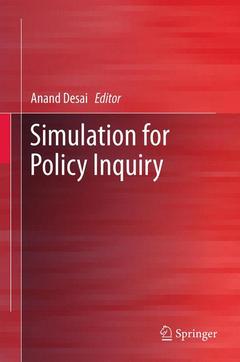Description
Simulation for Policy Inquiry, 2012
Coordinator: Desai Anand
Language: EnglishPublication date: 06-2014
232 p. · 15.5x23.5 cm · Paperback
Publication date: 05-2012
232 p. · 15.5x23.5 cm · Paperback
Description
/li>Contents
/li>Comment
/li>
Public policy and management problems have been described as poorly defined, messy, squishy, unstructured, intractable, and wicked. In a word, they are complex. This book illustrates the development and use of simulation models designed to capture some of the complexity inherent in the formulation, management, and implementation of policies aimed at addressing such problems.
Simulation models have long existed at the fringes of policy inquiry but are not yet considered an essential component of the policy analyst?s toolkit. However, this situation is likely to change because with improvements in computational power and software, simulation is now easier to include in the standard repertoire of research tools available for discovery and decision support. This volume provides both a conceptual rationale for using simulations to inform public policy and a practical introduction to how such models might be constructed and employed. The focus of these papers is on the uses of simulation to gain understanding and inform policy decisions and action. Techniques represented in this volume include Monte Carlo simulation, system dynamics and agent based modeling.
PART I.- 1.Simulation Design for Policy Audiences: Informing Decision in the Face of Uncertainty.- 2.Using Simulation as a Scenario Builder for Decision Making – A Case Study Using the Nurse-Family Partnership Program in Louisiana.- 3.The Utility of Multilevel Modeling vs. Agent-Based Modeling in Examining Spatial Disparities in Diet and Health: The Case of Food Deserts.- PART II.- 4.Urban Renaissance or Invasion: Planning the Development of a Simulation Model of Gentrification.- 5.Simulating Life Cycle Costs for Nuclear Facilities.- 6.Simulating a Fraud Mechanism in Public Service Delivery.- 7. Exploring Assumptions through Possible Worlds: The Case of Homeownership.- PART III.- 8.Simulating the Multiple Impacts of Deferred Maintenance.- 9.Pandemic Influenza Simulation with Public Avoidance Behavior.- 10.Iterative Storytelling in Public Policy: A Systems Thinking Approach Hightower.
Organized as a coherent whole to introduce simulation as a learning tool that can be used to understand and explore complex systems and to inform decisions
Contains authored papers by scholars working in various policy including policy informatics, public policy and management, public administration, and simulation
Uses examples that are readily accessible to those who are simply exploring the uses of simulation and also offers sufficient substantive and technical detail to be of interest to established users of simulations


